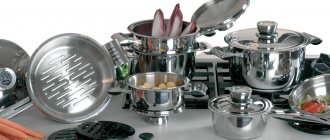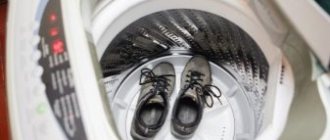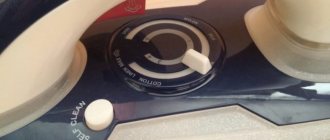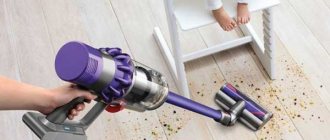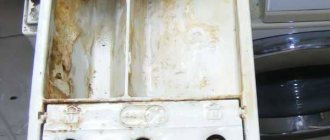The essence of the problem
The heat supply system for buildings, houses, and apartments consists of a boiler, pipes, and heating radiators. A coolant is supplied into it, which gradually releases heat, heating the air in the rooms. Usually this is hot water, which causes metal corrosion and scale on the internal surfaces of heating communications.
Are you looking for a life hack - how to wash the inside of a battery so that it lasts as long as possible? For this, it is important to take care of the outside, where dust, dirt, and in kitchens also soot and grease settle. How to wash the battery inside and out? Which means are best to use and which ones to avoid? What household appliances and cleaning equipment should I take to wash the heating radiator from dust, stains, and adhering dirt? Can I use hard brushes and abrasive pastes? I want the work to be easy and fast. We will tell you how to properly wash the inside of an accordion battery to restore its neat appearance.
Experts from the capital's Mactailor company have collected in this publication answers to the main questions that people who decide to wash their heating radiators have to solve. Professional cleaners know how to wash old cast-iron radiators or new models made of aluminum and steel. Since many housewives wash them themselves, we offer useful information on this topic. Each of our life hacks on how to wash the inside of an accordion battery will help you easily cope with complex work.
Why do you need to wash batteries?
Why is it important to know how to wash radiators? The fact is that radiators are usually installed under windows. Dust from the street air through vents or open windows settles primarily on them. Especially if the battery is in the form of an accordion, and you haven’t gotten around to cleaning it for years. The slightest draft or gust of wind lifts dust from the radiator into the air and spreads it throughout the rooms. People living or working indoors constantly breathe polluted air.
Questions arise:
- How to clean batteries from dirt?
- How to get to the inner surfaces of the sections, how to wash between the batteries?
- How to easily wash the inside of an accordion battery? The videos on the site will help you understand this.
- How to wash aluminum radiators and bimetallic batteries?
Cleaning batteries should be included in the mandatory list of maintenance cleaning tasks for housewives and professional cleaners. How and with what to wash them depends on the type of coating, design, and degree of contamination.
The instructions from radiator manufacturers indicate that when washing, you should not use metal brushes or abrasive materials that can damage the outer coating. This will cause corrosion and shorten service life.
It is important to know what they are made of and how to wash the batteries inside from dust, dirt, and grease. When purchasing, make sure that the seller provides you with instructions with technical characteristics and care rules. Then you will know exactly how to wash radiator batteries without harming them.
Why is it dangerous?
The sizes of dust particles are determined within the range from 0.00002 to 0.1 millimeters. Above forests, rivers, and lakes, its content does not exceed 1 milligram per cubic meter. In cities, dust levels can reach 20 milligrams per cubic meter. The structure of dust in an apartment/house primarily depends on finishing materials, service life and quality of furniture and household appliances.
Read also: What is BARGUZIN? Meaning of the word
The most common harm caused by household dust is allergies, which affect every tenth city resident. It is often confused with the common cold due to the similarity of symptoms. Allergies can result in bronchial asthma.
Dust allergies are primarily caused by saprophytic mites, insects up to 0.5 millimeters in size. In 1 gram of house dust there are up to 500 individuals that process organic dust components. Their waste product is guanine, an allergen that causes runny nose, conjunctivitis and asthma. In a city apartment, a person inhales 25 times more dust particles per minute than outside the city. Cleanliness in the house for city residents is important for maintaining health.
Read also: How to learn road signs
Materials and design of radiators: how does this affect their care?
To produce heating batteries, manufacturers use cast iron, steel, and aluminum. Copper and bimetallic batteries are available, with an internal frame made of stainless steel or copper and an outer shell made of aluminum. Housewives and cleaners should clearly know how to wash radiators without harming the outer coating and metal.
Based on their design, batteries are divided into flat (panel, tubular) and accordion-type. The latter option is gradually becoming a thing of the past. But there are still a lot of them in Russia - both in old houses and in designer projects in retro and vintage styles. That’s why Internet users often ask the question: how to wash accordion heating batteries inside and out?
Old cast iron batteries from sections cannot always be completely washed. As an alternative, you can suggest painting with high-quality paint or purchasing a decorative grille.
The simpler the shape, the fewer grooves and recesses, the less frequently the question arises of how to clean the battery from dust. The most labor-intensive to clean are old cast-iron batteries made of several sections with internal crossbars. The rough surface of cast iron allows dirt to stick and makes cleaning more difficult compared to smooth steel and aluminum surfaces. Not everyone knows how to quickly wash cast iron batteries inside the house or office. But you can learn this by using the life hacks of our experts.
How often should batteries be washed inside and out?
Dry cleaning should be done 1-2 times a week. Then during general cleaning you won’t need a hard brush or aggressive cleaning agent. It is better to do wet cleaning every week. Pay attention to hard-to-reach areas. If dirt or cobwebs have accumulated there, it is better to remove them immediately.
When cleaning batteries, you need to take care not to stain or damage the wall and floor coverings near them. You should choose a technology for cleaning the inside of a radiator from dust wisely. It is best to entrust the work to cleaners. They will find an effective way to wash a cast iron battery between sections using professional life hacks.
Features of cleaning aluminum products
Aluminum is a metal that reacts well with any elements. This leads to rapid oxidation of aluminum radiators. The consequences of such processes are rapid contamination of heating systems, which can lead to failure of the radiator. Therefore, aluminum structures must be thoroughly cleaned and their condition regularly monitored. Cleaning methods are similar to those listed above - you can use high pressure water, special chemicals, professional equipment, and improvised materials. It is important to remember that aluminum reacts poorly to alkalis, but positively to acids. This fact should be taken into account when choosing a cleaning product.
Battery cleaning products
To clean radiators at home, household cleaning chemicals are used. Good results are achieved with available products – laundry soap, baking soda, toothpaste. Cleaning companies use professional detergents.
It is not recommended to use phosphate and chlorine-containing detergents for cleaning radiators. They can cause rust. To protect against it, a clean, dry battery can be treated with an anti-corrosion compound.
What and how to quickly wash batteries from ordinary dirt and dust?
You can wash the battery with a solution of laundry or liquid soap. Dissolve a small amount of it in warm water, apply it to the surface with a cloth, wipe with a clean damp cloth, and wipe the radiator dry.
How to wash battery sections from grease?
You can clean the surface of the battery from grease using dishwashing detergent, such as Fairy. One cap of liquid is dissolved in a small amount of water, foam is whipped up, and applied to the battery. Repeat the procedure until the fat deposits are completely dissolved.
How to wash old cast iron batteries inside and out?
Dirty cast iron batteries that have been unwashed for a long time are difficult to wash. Use Domestos, Comet, Silit. Protect your respiratory system and hands when working with aggressive household chemicals. Thoroughly rinse it off the radiators with clean water so as not to pollute the air with harmful fumes.
Among the available means, aqueous solutions give good results:
- Baking soda (2 tablespoons in 2-3 liters of warm water).
- Citric acid (5 teaspoons in a quarter liter of heated water).
- Three percent hydrogen peroxide (100 ml in 2-3 liters of water).
Household appliances for washing batteries
How to quickly clean and wash the inside of old cast iron batteries? The following will be useful in caring for heating radiators:
- a regular vacuum cleaner with narrow attachments for cleaning hard-to-reach places;
- a hair dryer for blowing dust onto a damp cloth, which is used to hang the radiator from the wall;
- a washing vacuum cleaner, which must be handled with care, and also cover the wall and floor in the radiator area so as not to spoil the finishing materials with soap suds;
- steam generator with nozzles.
Work order
Before you begin directly removing dirt, you need to remove the protective screen, if any. The grate must be washed by placing it in a bathtub using warm running water. After the procedure, you need to wipe it dry with a dry piece of soft cloth. If there are significant stains, a soap solution will help remove them.
Using a vacuum cleaner
Dust that has accumulated between the body parts can be easily removed with a vacuum cleaner. To do this, you need to use a narrow nozzle, since with their help you can remove even the most inaccessible places.
Using a hair dryer
This method of dust removal is also effective. To do this, place a wet cloth on the wall located behind the radiator. This could be a diaper or an old pillowcase. To prevent dust and dirt from remaining on the wall, cover it with film and then attach the fabric. After this, you need to thoroughly blow the entire battery with air from a hair dryer. This will help blow away dirt and dust, which will then settle on the wet cloth. This cleaning method is suitable for frequent use, especially if the radiator does not have stubborn stains. The time required for this type of cleaning is about 10 minutes.
Using boiling water
This method is suitable for cleaning the radiator from significant stains. To do this you will need a wide baking tray, a kettle of boiling water and a rag. The container in which the water will be collected must be placed under the device, and the wall located behind it must be covered with film.
Next, you should very carefully pour boiling water over the battery. It will help wash away dirt that drains into the container.
Equipment: sponges, brushes, napkins
List of things you will need when washing radiators:
- Oilcloth or construction film to protect walls and floors from foam flowing from the radiator.
- A basin for soap solution and clean water for rinsing.
- A rag, a microfiber cloth, a sponge, a bottle brush, a paint brush with a long handle to remove cobwebs, dust, and dirt from the internal fins of the radiator.
- Damp cloth the size of the battery. It is attached to the back of the radiator to protect the wall when blowing dirt out with a hairdryer.
Now you know what and how to wash the crossbars in a cast iron battery. Let's move on to a description of the technologies.
Cleaning correctly is important!
Dust repellents only help when used correctly. First of all, you need to learn how to clean consistently.
How to wipe off dust correctly?
- You should move from top to bottom. First you need to wipe the chandeliers, baguettes, cabinets, and then the furniture and floor. If you do the opposite, dust from the upper tiers will fall down and cover already processed objects.
- You need to use a slightly damp cloth - this will collect dust most effectively. If you wipe it with a wet cloth, streaks will remain; if you use a dry cloth, dust particles will scatter throughout the room.
- Before wet cleaning, dry cleaning is carried out. You must first sweep the floor, vacuum the carpets and furniture. Then there will be fewer suspended particles in the air, and surfaces can be wiped clean.
How to quickly wash a battery: basic technologies
Cleaning uses dry and wet cleaning. Dry cleaning of batteries includes removing dust and blowing off any accumulated dirt between sections with a hairdryer. Wet cleaning is done manually, with a vacuum cleaner or a steam generator.
How to quickly wash cast iron radiator batteries inside? We will talk about this below. The main thing is that when caring for the batteries, the walls, floors, and window sills are not damaged.
Cover the walls near the radiator with film or oilcloth so as not to spoil the paint or wallpaper. The floor (laminate, parquet, solid board, marble) must also be covered with film or oilcloth. You can put a large reservoir on them for draining water. You should stock up on old newspapers and rags to quickly absorb moisture.
Dry cleaning the battery
It is recommended to perform it every time you clean, then the battery will always be clean. Dust is removed with a microfiber cloth. If you don't have one at hand, use a damp cloth, then wipe the radiator dry.
How to clean a radiator from dust inside? This can be done with a regular vacuum cleaner, choosing the narrowest attachments to penetrate hard-to-reach places.
Wet cleaning of a heating radiator
Before washing the battery, care should be taken to protect the finishing materials of the walls and floor. In addition, this will reduce the amount of dirt and shorten the procedure time.
Be sure to clean the battery with a vacuum cleaner before wet cleaning. By collecting dust, cobwebs, and small debris, you will make your work easier.
The surface of the radiator is washed with a prepared solution of soap, soda, hydrogen peroxide or a household cleaner. If there is a layer of fat on the battery, you should completely soften it with special chemicals, then remove it with a rag. At the end of cleaning, wipe the battery with clean water to remove traces of detergents, and then wipe dry with a clean cloth.
Algorithm for proper cleaning
Cleaning begins with putting things in their places. Items that are not regularly used are put away in cabinets, pantries, and shelves. Before removing or packing, dust must be removed from things:
- wipe;
- wash;
- vacuum;
- knock out.
To avoid mold, shoes, clothes, carpets, and soft toys should be dried, preferably in the sun. After tidying up the interior, you need to vacuum the floors so that dust does not rise into the air during cleaning.
Anti-dust treatment begins with textiles:
- curtains;
- curtains;
- bed linen;
- upholstered furniture;
- toys.
They are washed or treated with a steam generator.
Carpets and rugs are washed with foam and dirt is removed with a vacuum cleaner. The cleaning procedure can be carried out outdoors. It is easier to remove dust from dried products.
The next stage of cleaning is the most inconvenient. Need to wipe:
- corners and space between walls behind the refrigerator, cabinets, washing machine;
- ceiling;
- cornices;
- the top of the cabinets.
Whitewashed ceilings are brushed or vacuumed. Dust from the walls can be brushed off with a broom, sockets and switches are wiped, ventilation grilles are washed.
Then washed:
- doors (indoor and outdoor);
- pens;
- windows and window sills;
- chandeliers, sconces, table lamps;
- air conditioning filters;
- air conditioner;
- hood;
- mirrors;
- body of a refrigerator, washing machine.
Wipe clean using polishes or surface sprays:
- shelves (internal and external);
- furniture doors, walls;
- computer monitors;
- TV screens.
Leaves of indoor flowers are cleaned of dust. Give moisture-loving plants a shower. Before the final cleaning procedure, dirt is removed from under the beds. They vacuum again. The filters of the device are washed/replaced. All parts and surfaces of the vacuum cleaner are wiped. Wet cleaning is done throughout the entire room.
Cleaning the radiator inside from corrosion and scale
Our clients ask the most questions about the topic: how to wash old cast-iron batteries with fins inside? The work requires patience, time, physical effort, chemicals and equipment. If you don’t want to delve into the intricacies and waste energy on hard dirty work, invite professionals from a specialized company that provides servicing of heating communications.
The algorithm for performing the work will be of interest to those who want to know how to wash a cast-iron battery from the inside:
- water is drained from the heating system;
- the radiator is disconnected from two pipes - water supply and water outlet;
- move the sections to where the washing will take place (in the yard or in the bathtub);
- pour water into the battery, shake vigorously so that the water washes away deposits from the inner walls;
- then a special solution is poured inside, which will clean the walls of corrosion and scale in 10-15 minutes.
Now imagine the weight of a cast iron battery and you will understand how difficult it is to wash the battery inside in an apartment. Entrust the work to cleaners or a specialized service company. Craftsmen use a pump to supply water under pressure inside the battery and professional chemicals to remove rust and limescale. In addition, they know how to wash the radiators inside without removing them.
Cleaning process
Cleaning batteries should begin from the outside. Dust should be removed with a vacuum cleaner using a narrow nozzle or a hairdryer. Using a hairdryer you can easily “blow out” excess dust. Small stains can be removed with warm water. Stubborn dirt and grease can be removed using special cleaning products for complex stains. If you don’t find any, then vinegar and citric acid will do the job perfectly.
Clean the spaces between sections using a brush or vacuum cleaner attachment. Next, you need to move on to internal cleaning of the batteries. To do this you need to remove the radiator. Then remove the plugs from the pipe. The radiator must be placed in the bath. You need to pour hot water into the radiator. The battery itself also needs to be removed, water poured into it, rinsed and thrown away. Pour a special descaling solution or 9% vinegar into the radiator. Insert the radiator in place of one plug. The solution must be allowed to stand for at least 2 hours.
Next you need to shake the radiator. You need to tap the walls of the radiator with something metal, but not with a hammer. For aluminum batteries this procedure is not necessary. At the end, you need to rinse the radiator, pouring water until the remaining substances are completely removed. Then put everything in place. Residents of private houses can do without removing the battery. To do this, you need to bleed the heating system and turn on the water supply.
Thanks to this article, you can clean the batteries yourself.

